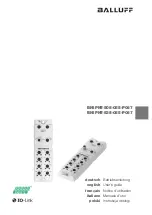
Page 13
Before disassembly prevent rope drum from free
spinning by wedging drum in place with a block of
wood, and resting lower block on work surface so
all weight is off rope drum. Rope may also be
removed from hoist drum.
WARNING
The complete mechanical load brake assembly is
heavy (approx. 150 lbs.). Provide adequate means to
support weight of assembly before removal from
gearcase, especially if brake assembly is removed
with hoist suspended.
WARNING
b. Remove compression plate, washer and lining assemblies,
springs and brake plates as described in Paragraph 5-
5.g. Remove hex nuts and hex head bolts holding
gearcase spider and remove spider. Inspect gearing for
tooth wear or damage, (see Figure 5-4). If replacement
parts are indicated, disassemble load brake and gearing
as follows:
(1) Pull out motor pinion shaft from gearcase, (see Figure
5-4).
(2) The complete load brake assembly can now be pulled
out from the gearcase or removed part by part.
Figure 5-4. View of Gearing - Spider Removed
10028
c. To disassemble and inspect mechanical load brake without
overload clutch, either in or removed from hoist, proceed
as follows:
(1) Remove the two (three on larger models) selflocking
screws from each of two retaining plates and remove
plates from groove on splines of brake shaft (Figure
5-5).
(2) Pull off brake helix (Ref. No. 12, Figure 9-4).
(3) Pull off brake gear (Ref. No. 11, Figure 9-4).
Note: It may be necessary to apply some force to
end of shaft when removing brake gear.
(4) Remove (1) friction washer, roller and ratchet
assembly, and another friction washer. The roller and
ratchet assembly should not be disassembled;
replacement, if required, as an assembly is
recommended.
(5) Remove brake shaft and flange assembly.
(6) Check condition of all parts for evidence of wear or
damage. Replace worn or damaged parts.
(7) Reinstall in reverse procedure from disassembly
making certain helix is seated and that retaining plates
are properly seated in groove on shaft spline (Figure
5-5).
d. To disassemble and inspect mechanical load brake with
overload clutch, either in or removed from hoist, proceed
as follows:
(1) Remove the two (three on larger models) selflocking
screws from each of two retaining plates and remove
plates from groove on splines of brake shaft (Figure
5-5).
(2) Pull off brake helix. Surface of brake helix may be
below brake adjusting collar (Ref. No. 24, Figure 9-4).
With some pressure on end of brake shaft, pull brake
gear toward end of shaft about one inch. Then return
gear to original position to expose outside of helix.
Grasp outside of brake helix and slide off from splined
shaft.
(3) Do not remove the overload clutch adjusting screws
unless clutch requires service. See Paragraph 5-6.e
below. Remove clutch and brake gear as one unit by
pulling off from brake shaft while exerting some
pressure on end of brake shaft.
(4) Remove (1) friction washer, roller and ratchet
assembly, then the other friction washer. The roller
and ratchet assembly should not be disassembled;
replacement, if required, as an assembly is
recommended.
(5) Remove brake shaft and flange assembly.
(6) Check condition of all parts for wear or damage.
Replace worn or damaged parts.
(7) Reinstall in reverse procedure from disassembly
making certain helix is seated and that retaining plates
are properly seated in groove on shaft spline (Figure
5-5).
e. Disassembly of overload clutch. It is recommended that
disassembly, inspection, and reassembly of the overload
clutch be performed by a factory approved SHAW-BOX
Repair Station. Fine adjustments can be made with clutch
installed. (See OVERLOAD CLUTCH ADJUSTMENT,
Paragraph 7-5.)
Содержание SHAW-BOX
Страница 66: ...NOTES ...
Страница 67: ...NOTES ...














































